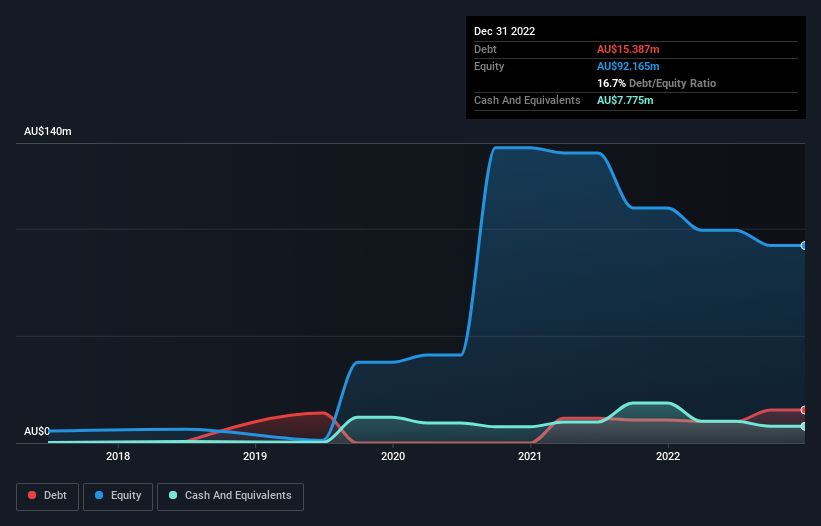Damstra Holdings (ASX:DTC) Has Debt But No Earnings; Should You Worry?
Warren Buffett famously said, 'Volatility is far from synonymous with risk.' When we think about how risky a company is, we always like to look at its use of debt, since debt overload can lead to ruin. We can see that Damstra Holdings Limited (ASX:DTC) does use debt in its business. But is this debt a concern to shareholders?
When Is Debt Dangerous?
Generally speaking, debt only becomes a real problem when a company can't easily pay it off, either by raising capital or with its own cash flow. In the worst case scenario, a company can go bankrupt if it cannot pay its creditors. However, a more usual (but still expensive) situation is where a company must dilute shareholders at a cheap share price simply to get debt under control. By replacing dilution, though, debt can be an extremely good tool for businesses that need capital to invest in growth at high rates of return. The first step when considering a company's debt levels is to consider its cash and debt together.
See our latest analysis for Damstra Holdings
What Is Damstra Holdings's Net Debt?
You can click the graphic below for the historical numbers, but it shows that as of December 2022 Damstra Holdings had AU$15.4m of debt, an increase on AU$10.8m, over one year. However, it does have AU$7.78m in cash offsetting this, leading to net debt of about AU$7.61m.

A Look At Damstra Holdings' Liabilities
Zooming in on the latest balance sheet data, we can see that Damstra Holdings had liabilities of AU$15.0m due within 12 months and liabilities of AU$17.4m due beyond that. Offsetting these obligations, it had cash of AU$7.78m as well as receivables valued at AU$3.99m due within 12 months. So it has liabilities totalling AU$20.6m more than its cash and near-term receivables, combined.
Given this deficit is actually higher than the company's market capitalization of AU$17.5m, we think shareholders really should watch Damstra Holdings's debt levels, like a parent watching their child ride a bike for the first time. In the scenario where the company had to clean up its balance sheet quickly, it seems likely shareholders would suffer extensive dilution. There's no doubt that we learn most about debt from the balance sheet. But it is future earnings, more than anything, that will determine Damstra Holdings's ability to maintain a healthy balance sheet going forward. So if you're focused on the future you can check out this free report showing analyst profit forecasts.
Over 12 months, Damstra Holdings reported revenue of AU$31m, which is a gain of 8.6%, although it did not report any earnings before interest and tax. That rate of growth is a bit slow for our taste, but it takes all types to make a world.
Caveat Emptor
Importantly, Damstra Holdings had an earnings before interest and tax (EBIT) loss over the last year. Its EBIT loss was a whopping AU$17m. When we look at that alongside the significant liabilities, we're not particularly confident about the company. We'd want to see some strong near-term improvements before getting too interested in the stock. Not least because it had negative free cash flow of AU$8.0m over the last twelve months. So suffice it to say we consider the stock to be risky. There's no doubt that we learn most about debt from the balance sheet. However, not all investment risk resides within the balance sheet - far from it. We've identified 2 warning signs with Damstra Holdings (at least 1 which is concerning) , and understanding them should be part of your investment process.
At the end of the day, it's often better to focus on companies that are free from net debt. You can access our special list of such companies (all with a track record of profit growth). It's free.
New: Manage All Your Stock Portfolios in One Place
We've created the ultimate portfolio companion for stock investors, and it's free.
• Connect an unlimited number of Portfolios and see your total in one currency
• Be alerted to new Warning Signs or Risks via email or mobile
• Track the Fair Value of your stocks
Have feedback on this article? Concerned about the content? Get in touch with us directly. Alternatively, email editorial-team (at) simplywallst.com.
This article by Simply Wall St is general in nature. We provide commentary based on historical data and analyst forecasts only using an unbiased methodology and our articles are not intended to be financial advice. It does not constitute a recommendation to buy or sell any stock, and does not take account of your objectives, or your financial situation. We aim to bring you long-term focused analysis driven by fundamental data. Note that our analysis may not factor in the latest price-sensitive company announcements or qualitative material. Simply Wall St has no position in any stocks mentioned.
About ASX:DTC
Damstra Holdings
Damstra Holdings Limited operates as an enterprise protection software provider in Australia, the United States, New Zealand, and internationally.
Adequate balance sheet and fair value.
Market Insights
Community Narratives



